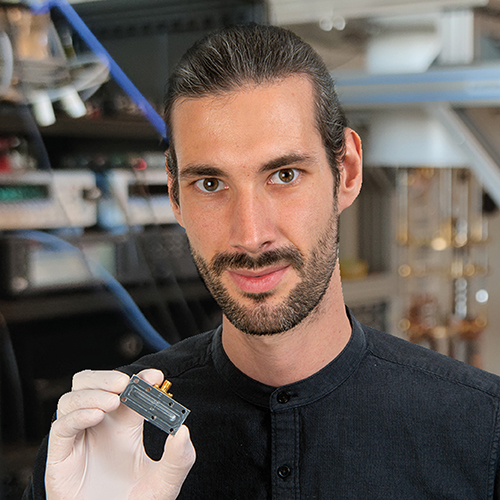
Matteo Fadel pushes the limit for the size of Schrödinger’s cat
03.07.2023 12:02
Branco Weiss Fellow Matteo Fadel has played a key role in two successful experiments that test the validity of quantum mechanics in the macroscopic regime of heavy physical objects, thus pushing our understanding of quantum mechanics.
In one project, published by Physical Review Letters journal, Dr. Fadel and his collaborators have managed to put a microgram-mass crystal into a quantum superposition state – an object size never reached before, and used it to test the predictions of quantum mechanics. Earlier tests could observe interference patterns due to wave-particle duality for molecules consisting of up to 2000 atoms. For their experiment, Matteo Fadel and his team used so-called acoustic wave resonators: little slabs of sapphire that are made to vibrate. The researchers were able to create quantum mechanical superposition states of a sapphire crystal consisting of 1016 atoms, weighing around 1 microgram. After putting the crystal into a specific quantum state, they found quantum features in its vibration for up to 40 microseconds.
“With some improvements we should be able to create even more macroscopic states in the near future, surpassing the results obtained with molecules and thus testing quantum mechanics in as yet unexplored regimes” Matteo Fadel is quoted saying on ETH Zurich’s website. The researchers’ goal is to find out what happens to quantum effects in the mass regime between atoms or molecules and macroscopic objects – and whether the currently used equations for describing quantum systems will have to be modified.
The second project, published in Science, aimed to better understand the reason behind the disappearance of quantum effects in the macroscopic world – why we can’t observe Schrödinger’s cat in our everyday surrounding. According to quantum mechanics, a physical system can be in any linear superposition of its possible states. Although the validity of this principle is routinely validated for microscopic systems, it is still unclear why we do not observe macroscopic objects to be in superpositions of states that can be distinguished by some classical property. So far, scientists managed only to do so with atoms or molecules.
The ETH Zurich-based team led by Yiwen Chu, professor at the Laboratory for Solid State Physics, with Dr. Fadel as co-first author, has now created a substantially heavier Schrödinger cat by putting a small crystal consisting of approximately 1017 atoms into a superposition of two oscillation states. “Our results offer the possibility of exploring the boundary between the quantum and classical worlds and may find applications in continuous-variable quantum information processing and metrology with mechanical resonators,” the authors state in their conclusion. In the future, the researchers would like to push the mass limits of their crystal cats even further.
Read the paper in Physical Review Letters
Read the paper in Science
Read the first news on the ETH Zurich website
Read the second news on the ETH Zurich website
Read the news in Physics
Read the news in New Scientist
Read the news in Spektrum der Wissenschaft (in German)
Read the news in Scientific American
Read the news in Wired
Read the news on Futura (in French)
